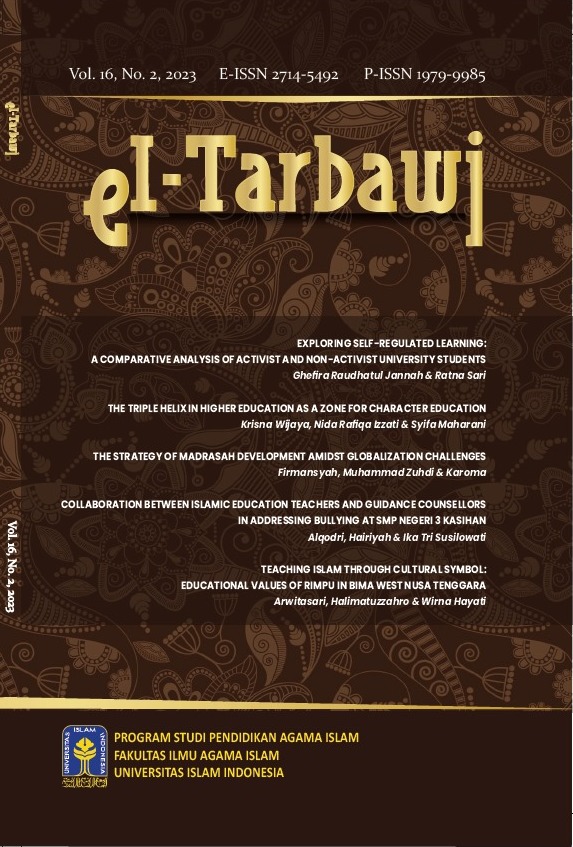Main Article Content
Abstract
Covering aurat is one of Islamic teachings in which its implementation can vary according to the local cultural context. In Bima, West Nusa Tenggara, Rimpu stands as the symbols for women in adhering to Islamic law by covering their aurat properly. This present research is a qualitative study with an ethnographic approach to understand the cultural meaning of Rimpu. The findings of this study implies: (1) the educational values in Rimpu are cultural values containing moral, decency, aesthetics, and religious values as the identity and cultural symbol of the Bima community, especially for Bima women who preserve Rimpu culture as a symbol of Islamic law. By using Rimpu, Bima women adhere to the teachings of the Quran to cover their aurat properly, (2) Rimpu culture is a symbol of women's morality in performing good or bad deeds. For this reason, Rimpu culture symbolizes good morality for women. As in Islamic teachings regarding aurat, Rimpu teaches the limits of aurat, protects women when they leave their homes, preserves the honour of women from the direct gaze of non-mahram men, and control direct interaction and communication with men.
Keywords
Article Details
Copyright (c) 2023 Arwitasari, Halimatuzzahro Marzuki, Wirna Hayati

This work is licensed under a Creative Commons Attribution-ShareAlike 4.0 International License.
Authors retain copyright and grant the journal right of first publication with the work simultaneously licensed under a Creative Commons Attribution (CC-BY-SA) 4.0 License that allows others to share the work with an acknowledgment of the work’s authorship and initial publication in this journal.
References
- Aeni, N. (2020). Kearifan Lokal Tradisi Rimpu pada Wanita Suku Mbojo di Desa Soro Kecamatan Lambu. Undergraduate Thesis, UMM Mataram, Mataram.
- Afifudi & Saebani, Beni Ahmad. (2012). Metodologi Penelitian Kualitatif. Bandung: Pustaka Setia.
- Alfan, M. (2013). Filsafat Kebudayaan. Bandung: Pustaka Setia.
- Arafah. (2015). Eksistensi Rimpu Mbida pada Masyarakat di Desa Simpasai Kecamatan Lambu Kabupaten Bima.
- Undergraduate Thesis, UIN Alauddin Makassar, Makassar.
- Aulia, R.N. (2013). Rimpu: Budaya dalam Dimensi Busana Bercadar Perempuan Bima. Journal of Qur'anic Studies
- Building the Tradition of Qur'anic Thinking 9 (2).
- Baharuddin. (2010). Sosiologi: Suatu Pengantar. Yogyakarta: Kurnia Kalam Semesta.
- Basrowi, David. (2005). Pengatar Ilmu Sosiologi cet,1. Jakarta: Ghalia Indonesia.
- Bertens, K. (1993). Etika. Jakarta: Gramedia Pustaka Utama.
- Black, J.A. (1999). Metode dan Masalah Penelitian Sosial. Bandung: Refika Aditama.
- Fatimah. (2017). Nilai-nilai Budaya Rimpu dalam Konteks Moralitas di Kalangan Perempuan Bima Desa Sakuru Kecamatan Monta Kabupaten Bima. Undergraduate Thesis, UMM Mataram, Mataram.
- Fitratunnisa. (2019). Nilai-nilai Pendidikan pada Budaya Rimpu di Desa Tangga Kecamatan Monta Monta. Thesis, UIN
- Maulana Malik Ibrahim Malang, Malang.
- Geertz, Clifford. (1992). Tafsir Kebudayaan. Yogyakarta: Kanisius.
- Inayah, N. (2019). Rimpu Tradisi Berbusana di Kalangan Perempuan Bima. Undergraduate Thesis, UIN Sunan Kalijaga, Yogyakarta.
- Koendjaranigrat. (2009). Pengantar Ilmu Antropologi. Jakarta: PT Rineka Cipta.
- Nata, Abuddin. (2008). Metodologi Studi islam. Jakarta: PT Raja Grafindo Persada.
- Novia, N. (2018). Eksistensi Tradisi Rimpu di Tengah Perkembangan Busana Modern di Desa Simpasai Kecamatan Sape Kabupaten Bima. Undergraduate Thesis, FDIK UIN Mataram, Mataram.
- Nuraeni, H.G. (2012). Studi Budaya di Indonesia. Bandung: PustakaSetia.
- Nucci, L.P., Narvaez, D. (2014). Handbook of Moral and Character Education. NY: NYU Press.
- Ritzer, G., Goodman, D.J. (2008). Teori Sosiologi. Yogyakarta: Kreasi Wacana.
- Setiadi, E. M. (2006). Ilmu Sosial dan Budaya Dasar. Jakarta: Penada Media Group.
- Fitriana, Ayu & Suharno. (2019). Budaya Rimpu sebagai Eksistensi Perempuan Islam di Tanah Bima. Journal of Anthropology Socio-cultural Issues, 21 (2). Taufan, N.I. (2012). Warna-Warni Tradisi Sasak Samawa Mbojo. Bima: Samparaja Bima Cultural Museum.
- Ulya, N.K. (2017). Resepsi Konsep Menutup Aurat dalam Tradisi Pemakaian Rimpu. Al-Bayan Journal of Qur'anic Studies 2 (2).
- Yuliningsih, D. (2013). Eksistensi Budaya Rimpu di Bima Nusa Tenggara Barat. Undergraduate Thesis, State University of Yogyakarta, Yogyakarta.
References
Aeni, N. (2020). Kearifan Lokal Tradisi Rimpu pada Wanita Suku Mbojo di Desa Soro Kecamatan Lambu. Undergraduate Thesis, UMM Mataram, Mataram.
Afifudi & Saebani, Beni Ahmad. (2012). Metodologi Penelitian Kualitatif. Bandung: Pustaka Setia.
Alfan, M. (2013). Filsafat Kebudayaan. Bandung: Pustaka Setia.
Arafah. (2015). Eksistensi Rimpu Mbida pada Masyarakat di Desa Simpasai Kecamatan Lambu Kabupaten Bima.
Undergraduate Thesis, UIN Alauddin Makassar, Makassar.
Aulia, R.N. (2013). Rimpu: Budaya dalam Dimensi Busana Bercadar Perempuan Bima. Journal of Qur'anic Studies
Building the Tradition of Qur'anic Thinking 9 (2).
Baharuddin. (2010). Sosiologi: Suatu Pengantar. Yogyakarta: Kurnia Kalam Semesta.
Basrowi, David. (2005). Pengatar Ilmu Sosiologi cet,1. Jakarta: Ghalia Indonesia.
Bertens, K. (1993). Etika. Jakarta: Gramedia Pustaka Utama.
Black, J.A. (1999). Metode dan Masalah Penelitian Sosial. Bandung: Refika Aditama.
Fatimah. (2017). Nilai-nilai Budaya Rimpu dalam Konteks Moralitas di Kalangan Perempuan Bima Desa Sakuru Kecamatan Monta Kabupaten Bima. Undergraduate Thesis, UMM Mataram, Mataram.
Fitratunnisa. (2019). Nilai-nilai Pendidikan pada Budaya Rimpu di Desa Tangga Kecamatan Monta Monta. Thesis, UIN
Maulana Malik Ibrahim Malang, Malang.
Geertz, Clifford. (1992). Tafsir Kebudayaan. Yogyakarta: Kanisius.
Inayah, N. (2019). Rimpu Tradisi Berbusana di Kalangan Perempuan Bima. Undergraduate Thesis, UIN Sunan Kalijaga, Yogyakarta.
Koendjaranigrat. (2009). Pengantar Ilmu Antropologi. Jakarta: PT Rineka Cipta.
Nata, Abuddin. (2008). Metodologi Studi islam. Jakarta: PT Raja Grafindo Persada.
Novia, N. (2018). Eksistensi Tradisi Rimpu di Tengah Perkembangan Busana Modern di Desa Simpasai Kecamatan Sape Kabupaten Bima. Undergraduate Thesis, FDIK UIN Mataram, Mataram.
Nuraeni, H.G. (2012). Studi Budaya di Indonesia. Bandung: PustakaSetia.
Nucci, L.P., Narvaez, D. (2014). Handbook of Moral and Character Education. NY: NYU Press.
Ritzer, G., Goodman, D.J. (2008). Teori Sosiologi. Yogyakarta: Kreasi Wacana.
Setiadi, E. M. (2006). Ilmu Sosial dan Budaya Dasar. Jakarta: Penada Media Group.
Fitriana, Ayu & Suharno. (2019). Budaya Rimpu sebagai Eksistensi Perempuan Islam di Tanah Bima. Journal of Anthropology Socio-cultural Issues, 21 (2). Taufan, N.I. (2012). Warna-Warni Tradisi Sasak Samawa Mbojo. Bima: Samparaja Bima Cultural Museum.
Ulya, N.K. (2017). Resepsi Konsep Menutup Aurat dalam Tradisi Pemakaian Rimpu. Al-Bayan Journal of Qur'anic Studies 2 (2).
Yuliningsih, D. (2013). Eksistensi Budaya Rimpu di Bima Nusa Tenggara Barat. Undergraduate Thesis, State University of Yogyakarta, Yogyakarta.
